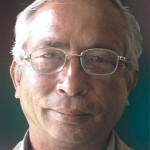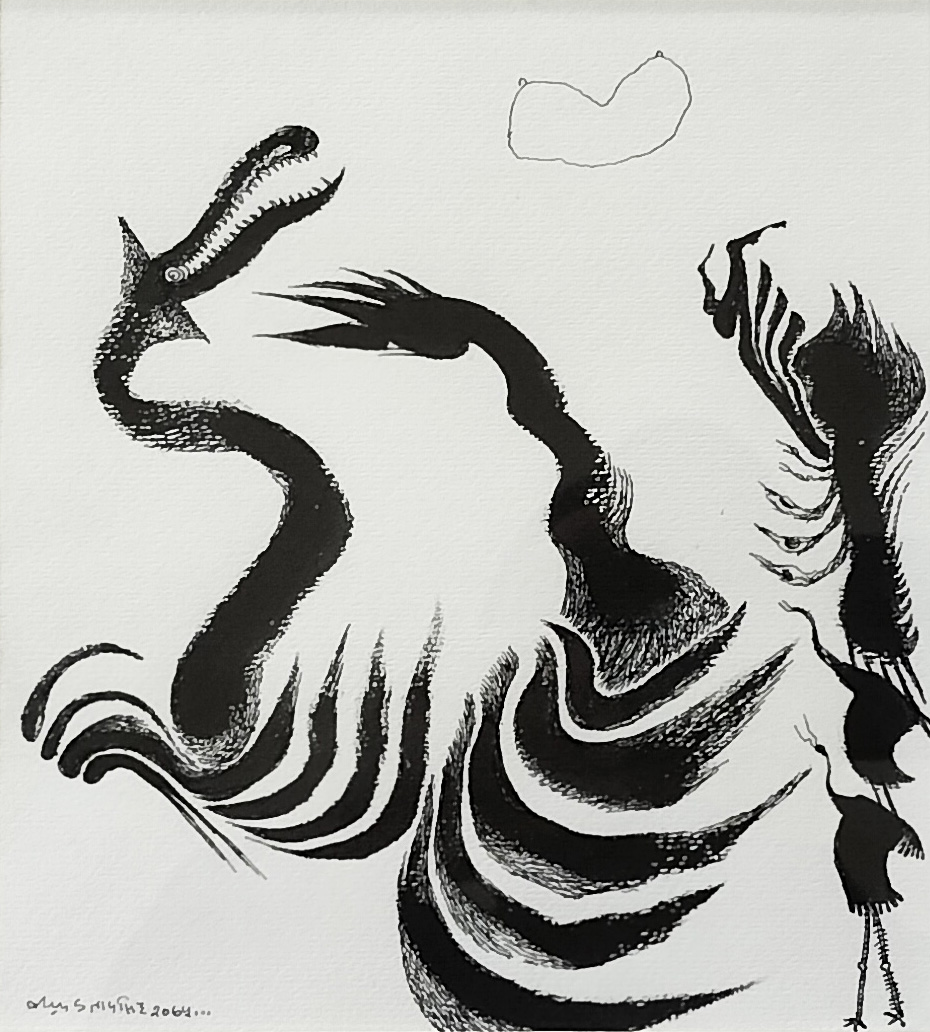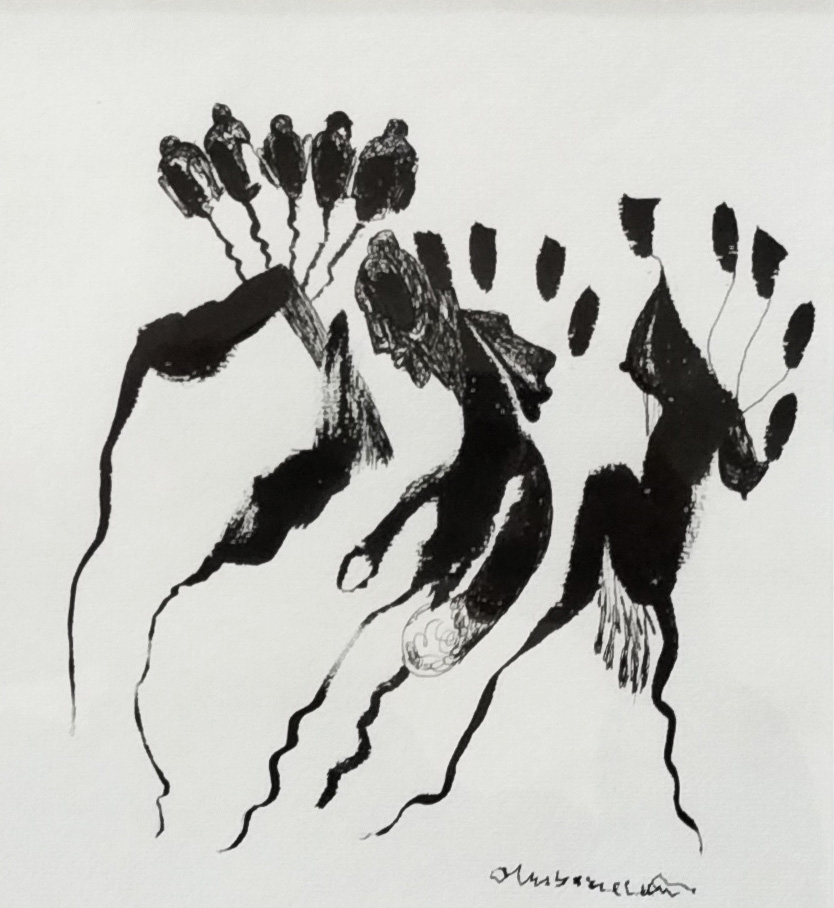Birendra Pratap Singh

However, the presence of birds may signify other things as well. Maybe the birds like crow and vulture are anticipating to devour the human flesh after the sick patients will be dead. This is the ironic situation in the sense that as one is one in agony and pain, the other is expecting satisfaction and joy. This is analogical to the human condition, for we have known the people who rejoice in the tragedy and fall of the others. While these bird soar the sky with joyful gesture, Birendra’s frail and fragile men and women are trapped by their own diseases.
Birendra Pratap Singh’s works depict multiple perspectives of the human beings and their surroundings. He captures the landscapes of nature to the cityscapes of ancient town. His latest series “Electrocardiogram – Internal Stories” dissects the human existence to its core with fascinating forms. As the medical process, electrocardiogram (ECG) scans the human body, the artist attempts to represent the inner reality of human existence.
The disfigured, distorted and ailing human bodies give a sense of eccentricity and horror at the same time. The paintings created in acrylic and mixed media on paper appear as the exploration of medical case histories. At a first glance, these paintings look mono-chromatic and repetitive but close scrutiny reveals that they are the records or progression or onset of a disease. The use of very dark colours and quirky images present a scenario of the vagueness of the ailment and the angst of the patient. The portrayal of faceless figures in a state of agony make the viewers imagine their own condition when they become sick.
In some paintings, the artist places a rectangular shape in the middle of these ailing figures. This geometric shape represents the electrocardiogram (ECG) that reveals the real internal medical condition of these patients. A delicate wash of copper applied over some figures represents red blood cells. In others the artist uses silver color to suggest a problem related to white blood cells. Some of his works depict hovering black birds above these figures to symbolically present a bird’s eye view of a scenario of sickness.
However, the presence of birds may signify other things as well. Maybe the birds like crow and vulture are anticipating to devour the human flesh after the sick patients will be dead. This is the ironic situation in the sense that as one is one in agony and pain, the other is expecting satisfaction and joy. This is analogical to the human condition, for we have known the people who rejoice in the tragedy and fall of the others. While these bird soar the sky with joyful gesture, Birendra’s frail and fragile men and women are trapped by their own diseases.
Standing patients in a bewildering queue are waiting their turn to be operated. Some are on their way to a heart attack and are rather grimly waiting death. Birendra’s bizarre human figures appear to be in the loosing battle against death. Some other human figures interestingly show their trust and hope in God before the operation. The scientific facts and spiritual belief are intermingled.
In addition to the Electrocardiogram series, Birendra has captured the cityscape of ancient towns along with traditional sculpture, architecture, religious rituals and socio-cultural images. The crumbling sculptures and architectures in Bungamati, Bhaktapur, Dhulikhel are presented to make the viewers aware about our vanishing heritage.
He has also created a series on ‘Thakkhola’, a well-known medieval salt route to Tibet. He has portrayed the endangered environment and artistic heritage of Thakkhola. The crumbled ancient temples depict the artist’s prophetic vision that in so called new Nepal, traditional values and establishments are about to be dismantled.
Born : 1956 AD
Education :
Graphic Printmaking, Lalit Kala Academy, India 1977
BFA Painting, Banaras Hindu University, India 1976
Graphic Printmaking, Lalit Kala Academy, India 1980
Member :
Nepal Association of Fine Arts
Young Artist’s Group
Advisor Committee – Nepal
Association of Fine Arts (NAFA)
Currency Design Committee-Nepal Rastra Bank
Solo Exhibitions :
1976 : “Transmulation” – Indian Cultural Center, Kathmandu
1981 : “Graphic Drawings” – Lalit Kala Academy, India
1982 : “Graphic Drawings” – Indian Cultural Center, Kathmandu
1987 : “Ganga” – Sirjana Art Gallery, Kathmandu
1994 : “Save Bungamati” – J Art Gallery, Kathmandu
1995 : “Environment” – J Art Gallery, Kathmandu
1995 : “Bungamati to Banglung” – J Art Gallery, Kathmandu
1997 : “Painting and Drawing” – J Art Gallery, Kathmandu
2004 : “Drawing Exhibition” – Buddha Gallery, Kathmandu
2009 : “Homage to Heritage” – Siddhartha Art Gallery, Kathamandu
Group Exhibitions :
1970-74 : National Art Exhibition, Kathmandu
1976 : Junkiree 76, International Hall, BHU, India
1977 : Junkiree 76, Royal Nepal Academy, Kathmandu
1978 : Junkiree 76,Indian Cultural Center, Kathmandu
1978-79 : National Art Exhibition, Kathmandu
1979 : All India Exhibitions of Prints, Chandigarh, India
1980 : Graphic Exhibition, Ruskin School of Arts, Oxford, UK
1981-84 : National Art Exhibition, Kathmandu
1981 : 1st Asian Art Biennale, Dhaka, Bangladesh
1982 : 5th International Art Exhibition, Delhi, India
1983 : 2nd Asian Art Show, Fukuoka Art Museum, Fukuoka, Japan
1986 : Seoul Contemporary Asian Art Show, South Korea
1992 : SAARC Art Exhibition, Bangalore, Delhi, India
1993 : Girl Child of Nepal, UNICEF, Kathmandu
1993 : Nepalese Contemporary Art, Culcutta, India
1990-94 : Christmas Collection, Sirjana Contemporary Art Gallery, Kathmandu
1994 : 4th Asian Art Show, Fukuoka, Japan
1995 : 6th Asian Art Biennale, Dhaka, Bangladesh
1995 : Painting Exhibition, Seoul, South Korea
1999 : Painting Exhibition (CAPPING), Meguro Art Mesume, Tokyo, Japan
2004 : “Nepali Water Colour Paintings in Retrospect”, Kathmandu
2005 : “Celebrating Lines” Siddhartha Art Gallery, Kathmandu
2008 : “Amalgam” Siddhartha Art Gallery, Kathmandu
Collections :
Lalit Kala Academy, India
Birendra Art Gallery, Nepal
Fukuoka Art Museum, Japan
Private Collections in Nepal and Abroads
Tribhuvan International Airport, Kathmandu, Nepal
Visit :
India, Bangladesh, UK, Germany, Russia, Azerbijan, Italy, Switzerland, Belgium, Luxumberg, Netherlands, Thailand, Japan



